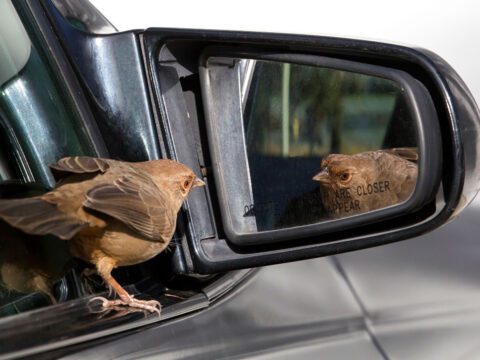Slow Down and Enjoy These High-Speed Birds and Beetles in Action [video]
By Shailee Shah, Cornell student May 29, 2013A chameleon’s tongue, a bee’s flight, a cheetah’s chase, a kingfisher’s dive, a manakin’s “singing” wings—many animals go about their lives doing things in the blink of an eye. There is a whole secret world of the fast-moving that remains to be explored and understood with the aid of high-speed videography.
I had my first opportunity to record with a high-speed camera over spring break in southern California. I was one of six Cornell students in a 10-day recording workshop taught by the Cornell Lab’s Macaulay Library. Though I had seen plenty of slow-motion film before, it was mind-blowing to watch and record animals moving around at normal speed, and then play back the sequence in slow motion.
A normal video or movie plays at 24–30 frames per second (fps), which is enough for our eyes to perceive motion. But animals can move much faster. A hummingbird can beat its wings more than 50 times a second, making it a complete blur to the naked eye.
The high-speed camera we brought, a Sony FS700, can shoot at 240 fps. In a nutshell, this means that it slows down movement by eight times, stretching a second of real time to eight seconds of video. In the clips above, it’s almost magical to see what animals are really doing in the blink of an eye.
For example, driving through the Carrizo Plain—a vast, arid grassland east of San Luis Obispo—looking for pronghorns and Prairie Falcons, we noticed a host of scarab beetles flying about. So we got down on our hands and knees and filmed one taking off from a rock. A quiver of antennae, a sudden unfolding of wings and it was gone, launching itself in the air in a split second. Played back in slow motion, the elegance of the beetle’s flight is revealed as its metallic orange wings fold out, like an entomological Transformer, and it seems to hover its way into the air.
Similarly, some Costa’s Hummingbirds foraging at Joshua Tree National Park prompted us to take high-speed videos of the birds in flight, hovering around bright chuparosa flowers and flying in for a quick sip of nectar. At 240 fps, the camera teases out the circular motion of the wings from the indistinct hum perceived by the naked eye. A kindly employee of the Oasis of Mara visitor center showed us a Costa’s Hummingbird nest right outside an office window. The female kept appearing out of nowhere, shooting in to supply her two young with regurgitated food and then taking off again. Shot at high speed, her graceful landing was the icing on top of a whole morning spent desperately trying to film these darting, three-inch-long organisms that act more like insects than birds.
Even “slower” shorebirds like avocets, whimbrels, and egrets perform predatory maneuvers that defy human speeds. Watching a Snowy Egret foraging on the beach, we were taken aback every time it managed to nab a springtail from the hundreds jumping about all around it. Slowed down with high-speed video, the egret’s split-second process of singling out a morsel, correcting aim, and grabbing it is revealed.
Needless to say, we were all blown away by these beautiful videos. And what makes this technology even cooler is how it can be applied to the scientific study of things like the feeding morphology of hummingbirds and shorebirds.
Our human sensory organs are by no means perfect. There are colors we cannot see, sounds we cannot hear, textures we cannot feel, speeds we cannot process. Technology like high-speed videography can help make these phenomena accessible to our sensory range and uncover the secrets of this hidden world, an opportunity that we were very fortunate to have as students on this expedition.
(Shailee Shah ’14 is a Cornell senior majoring in Biology and English. The expedition was organized by the Cornell Lab’s Macaulay Library and led by Benjamin M. Clock, Martha Fischer, and Larry Arbanas. Student participants included Mary Margaret Ferraro, Nathaniel Young, Andy Johnson, Teresa Pegan, and Luke Seitz. In addition to videography the students learned audio recording techniques and helped gather recordings of key species for the Macaulay Library archive.)


All About Birds is a free resource
Available for everyone,
funded by donors like you






